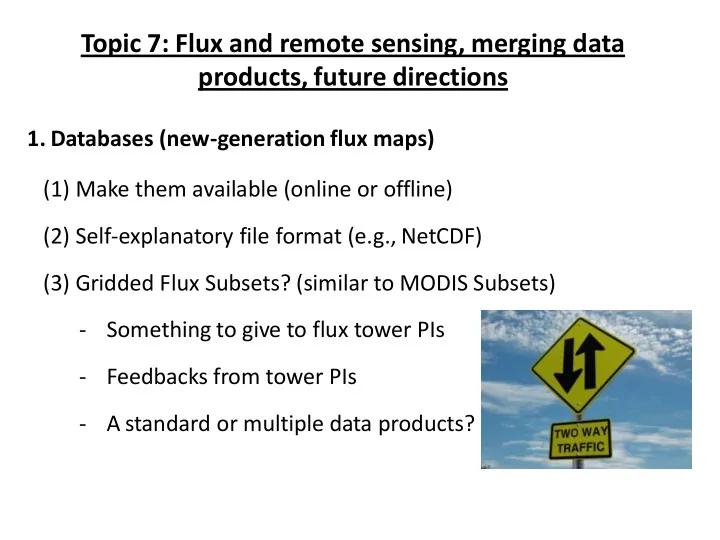

Topic 7: Flux and remote sensing, merging data products, future directions 1. Databases (new-generation flux maps) (1) Make them available (online or offline) (2) Self-explanatory file format (e.g., NetCDF) (3) Gridded Flux Subsets? (similar to MODIS Subsets) - Something to give to flux tower PIs - Feedbacks from tower PIs - A standard or multiple data products?
2. Future directions (1) Start to account for disturbance effects (2) Uncertainty assessment (input data, scaling, parameters, model structure) - > “true” uncertainty bounds (3) Evaluate ecosystem services (e.g., carbon sequestration, food and wood production, water yield) (4) Evaluate and improve Earth System Models (ESMs) (5) Merging data products and intercomparison - Juxtaposition of upscaling methods and gridded flux fields - RCN II? - Resources to facilitate this exercise
Data Management/User Support Deb Agarwal – Berkeley Lab Gilberto Pastorello – Univ. of Alberta
What does data synthesis support infrastructure look like? • Evolves – Archive(s) of raw data – Federated catalog of data locations/inventories – Development of data products – Integrated database – Data analysis tools and support – Rama’s knowledge center
Developing the Knowledge-base • Publications – linked to data/methodology • Documentation of collection and processing methods – Publication of methodology – Visual flow description/assumptions detail – Enabling an external user to understand and repeat • Metadata collection and maintenance – Calibration – Disturbances – Biological information – Descriptions • Development of a living data management system/ecosystem • Ability to drill down from end product all the way to original raw data
Standards • Equipment • Metadata • Data formats – Raw – Processed • Data products • Data sharing formats/methods • Data access rules
Constraints • Science objectives – Budgets – Products • Man power (passionate people) • Level of maturity of the technology/processing/standardization
Where do we go from here? • Footprints? • Synthesis efforts? • Data products? • Development of a data management plan to support? • Fluxdata.org blog available as a discussion portal
FLUXNET and Remote Sensing: Open workshop Berkeley, June 2011 FLUXCOM(P) – Intro for discussion
FLUXCOM – motivation and goals • Structurally different approaches to up-scaling from flux-towers to continent and globe (Xiao et al, Ichii et al, Jung et al., Beer et al., Fisher et al, Papale et al.,….) Common question: How do we make use of the information from FLUXNET at site level and integrate with “global data” (remote sensing, reanalysis)?
Similar situation as atm C-science years ago Key differences (“advantage FLUXNET”): Flux predicted from flux ( crossvalidation possible) • Spatially explicit at potentially high resolution • Wind fields, Transport modelling IPCC 2007 High-temporal resolution possible (incl. diurnal) • Atmospheric CO 2 concentration Large-scale biosphere-atmosphere network flux estimates Remote sensing and meteo fields, „ Biosphere “ modelling Spatially explicit flux estimates Bio-Atm flux network
Proposal to use LaThuille synthesis data
Questions to be discussed • Who wants to participate to this community effort? – Create predictor variables (locally, globally) – Apply up-scaling algorithm (core of intercomp) – Analysis of intercomparison – come-up with mailing list • What is an appropriate protocol? – Compromise between comparability and “freedom” – Compromise between wishes and feasibility – Addressing uncertainties (obs data, representation, driving data)
Towards a protocol (suggestions) • Output target – Limited by drivers and comp efficiency – Monthly/sub-monthly(?) fluxes (carbon, energy) – 0.5° latlon tiled by IGBP vegetation type • Predictors – Let’s make a list what is already used (must be available globally…) • E.g. Short-wave rad, VPD, Tair, Precip, wind speed • EVI, NDVI, FAPAR, LSWI, soil moisture… • Training/Validation/Application approach – One standardized approach with minimum data set (same predictors, and grids only differ on “how” information is extracted (feature selection, machine learning algorithm) – Factorial approach wrt drivers (x meteo data sets, y FPAR sets) for some approaches – Free approach….
A list… Approach / PI / email Predictors Target variables
Recommend
More recommend